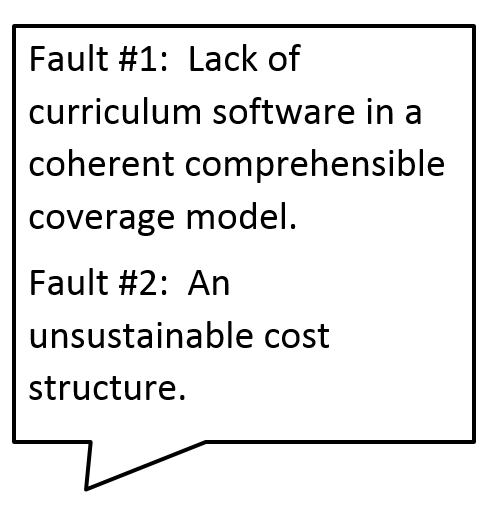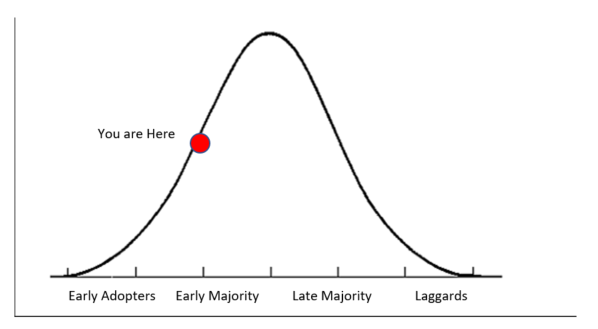What is going on with Ed-Tech transition right now? Like last year, loads of industry reps are getting knocked around. Companies fire whole battalions of them at once. Then they show up in other companies. The volatility is enough to take anyone’s breath away. Here is what is really happening, some advice, and some hope for the survival of both sides – educators and industry.
The market is maturing.
Let’s be real, Ed-tech purchases to date have pretty much been side-show-Bob sort of stuff, largely augmentative and not truly transitioning the whole market into new states of being. Altered supplemental tech play is not like the difference between shopping at local Sears and shopping on Amazon. Neither is going to a County Fair like going to Disneyland. Or running a restaurant like being the data manager at the C.I.A. The real, real transition is yet to come. It’s going to get more sophisticated.
Most schools have been throwing tech into the classroom. Schools have been getting requests up from teachers and fulfilling them, while doing the usual other bureaucratic things. Early adopting large districts got deep into major systems, but the bulk of the market doesn’t “systems think” at all. They “classroom think.” Things like Google Class and manipulating a few files is groovy because the early majority of the market is just now starting to mature into the real change of how you administer via tech.
The way of the industry has been sell to the classroom hot-buttons schools have, or sell to the executive hot-buttons of testing analytics and giant complex systems.
Both of those ways are largely over as of 2016.
The reigning in of willy-nilly spend on random bits and parts of hardware and chunks of software are so last year. This year is all about getting your act together as a school with a full-on strategy that melds both levels together of classroom function with administrative function. The mid-tier executive or leaders is where all the traction is now. The market has largely left the enthusiastic early-adopters on the curve of maturity and is now nearing the top of the first half of the early majority. This bell-curve of adoption is where real selling has to start happening. On both sides – the products by all the sales reps, and getting high-level executives in schools “all-in” to transition by securing budgets from their Superintendents and Boards. This means, finally, a toppling of the old book budget into the bucket of digital curriculum and the changed landscape of tech delivery.
The early and late majority are not the early-adopters.
Early adopter schools were so easy to sell. They sought out industry reps. They fell into your lap like ripe fruit. They bought just about anything you asked them to. Life was fine for industry. It was also not much money in the grand scheme of school spending.
Again, over. Way more money and way more effect is at stake now. The early and late majority of schools aren’t used to this chaos in Ed-tech and are extra careful. Again, most of them are run by leaders who are not “systems thinkers,” at least not from a software-runs-my-enterprise view. They still largely lead via people and policy only. Efficiency of time and predictability of reporting aren’t top of mind always. School-day schedules and bells ringing for the next class are the routines they know. The untethered and mobile world of screen learning seamlessly blended into experiential project-based learning, with every child on a completely personalized path and maybe mixed age groups, whoa! You’re talking coo-coo now is what the Superintendent says. Yet, we’re seeing Districts fall into wholesale shift one-by-one.
By the end of this year eighty-five percent of students will have devices for a significant portion of the day in the U.S. However, all that device purchase will have two faults that thoroughly bother the executives in schools. Fault number one: Lack of curriculum software in a coherent comprehensible coverage model. Fault number two: An unsustainable cost structure.
The reason for these faults are not blame-worthy at all, they’re just part of maturing. It goes something like this for most schools as they adopt Ed-tech.
- For the third time, a non-systems view of implementation – due to the one-offing of a lot of software in every flavor imaginable, other one-offing even in hardware and not keeping track, the running-of-things-from-the-bottom-up, lots of Open Education Resources (OER), and
- A disregard of transitional structural change that matches the change of teaching and learning dynamics, that together with the (1) non-systems view causes….wait for it,
- A frozen budget because nothing moved from old budgets or staffing to pay for what is basically a new delivery model of learning. “Automation” was for teachers and not really for the students. Ah, the crux of the matter.
Company reps and teachers say, yeah, yeah, whatever. They might not be getting the significance of this, but it means no money will be what they hear the most. The Education market, like others that have gone before, has hit its point of inertia, a.k.a. the greatest point of resistance. We’ve all just witnessed the bulk of the retail world go through years of resistance only to see truly majestic failure, like closing 150 stores in one week. In the face of Amazon, retailers like Walmart, JC Penney’s, Sears and whole malls are closing across America. In the meantime, Mathnasium is up to 700 stores nationwide already and growing. Schools worried about private schools, then they worried about charters, then homeschooling and unschooling, and now this? This blasphemous retailing consumerization of learning? Yes. It’s happening. There’s a whole book about this and how to survive called The Consumerization of Learning.
The greatest point of resistance will mean large loss of jobs on both sides, education institutions and companies, due to the mortal lockdown of true transition at exactly the same time alternatives, including straight-up consumerized learning Apps and online sites and organizations blossom, and the roving eye of the public goes elsewhere. Faster. Then quicker than we know, the market dissipates into a sort of Uberization or Amazonization type of reality. I wouldn’t be telling you this if it was not so obvious and so critically important a time to defend some of what is great about schools and teachers. For one thing, teacher-student human interaction is perhaps the last line of defense in many ways to making little humans human. Plus, it’s not one-hundred percent guaranteed, at least we hope not.
The fact is, education has more money right now in America than any time in history and now is the time, while the iron is hot and there are decent resources, for everyone to sell the future. Hard. Don’t soft-petal anything. Districts and schools still mostly just spend on the old ways of spending – salaries and buildings are the vast bulk of the budget. Eighty percent of the book budgets have yet to shift for crying out loud! There are still districts dropping huge wads of cash on books while buying millions of dollars in computing devices.
Watch the latest market briefing for more information on education trends:
Yeah, yeah, we know that, you are probably saying. Not a lot we can do about that. No? Well, that’s what transitioning really is folks. Welcome to the big leagues. The tough part is here, people, for both sides. For everyone with any stake in education from any level and any political orientation. You either protect jobs or you automate, you move budgets from one thing to another to survive. That is the conundrum of this Age, for everyone. As a rep you either sell hard or continue to show up at trade shows and then not bother to call anyone. Ever. You don’t do anything unusual, and hope revenue continues to pour in like the good old days.
As an educator, you either embrace what will help the whole institution survive, or you sacrifice the future for a generation, and probably for you and everyone you work with.
For educators, this is where you make the choice to marry the one your Parents approve of, the Board and County approve of, that students carry in their backpack, that everyone is “used to,” or you launch off into a beautiful song of love with the hot tech babe promising personalized adaptive curriculum that thrills every child with animated do-dads while teaching them calculus by the time they are 13. You pivot teachers and the whole scheduling of things to center on experiential learning, projects, great community and social-emotional interactions. You draw audience loyalty through a promise of great experience. That pivot is the new competitive stance. You move some of your best into digital curriculum management and allow attrition of teachers or don’t fill some of the empty slots so you don’t have to fade away as a whole organization. Then build it all up again with a lot more new staff. (Don’t worry, we predict there will be a net gain in total employees in Education, we just have to get through the “bottleneck” of a smaller overall student population at the same time the transition is going to pull budgets in odd tangents.)
The question for education is: Are you going to play it safe or are you going to dance?
One of the smartest Superintendents I know, Dr. Darwin Stiffler of Yuma, said last year in the Learning Counsel’s Phoenix event that he “didn’t want to be the last of the dinosaurs.” One of the best truths heard in a while.
See, if you’re a sales rep, a.k.a. consultant or business development or marketing person, or on the converse side in Education as the Curriculum Director or Tech Director, the one thing you need to do right now on every front is push. Get into deep philosophical conversation as to where this is all going.
Be the future, not the past.











